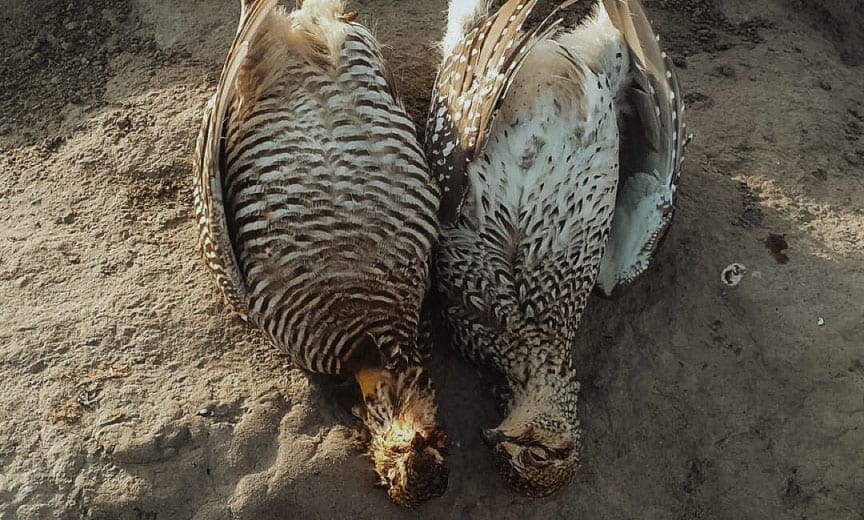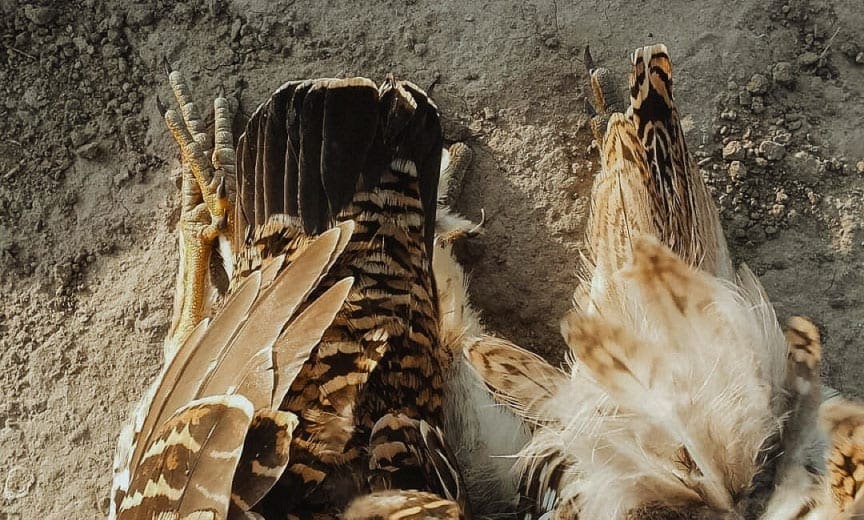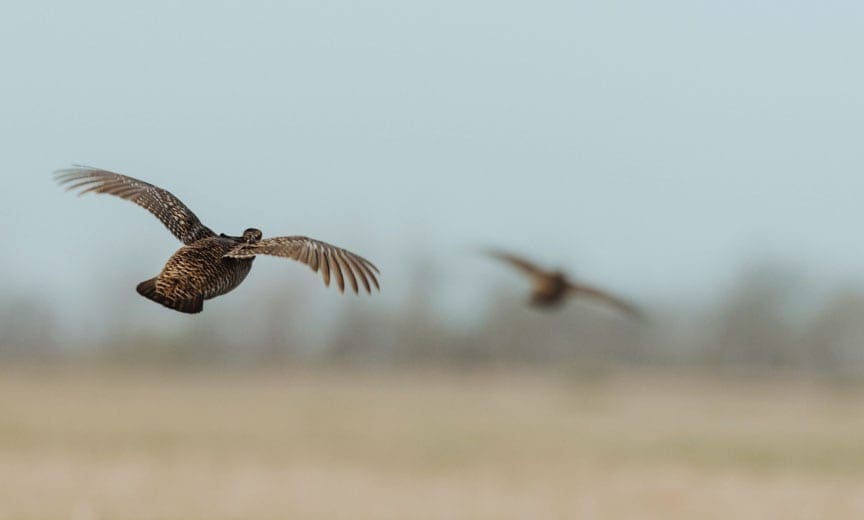Table of Contents
Learn to identify the differences between a prairie chicken and a sharp-tailed grouse.
A trio of hunters spaced out over forty yards from each other with two pointing dogs covering the large expansive prairie walked towards the horizon. The dogs were quartering back and forth as they crested an upland slope searching for scent. Suddenly the dogs began to act “birdy.” As if someone hit the pause button on the TV remote, the dogs froze in mid-stride. The hunters approached with anticipation. Shotguns were transitioned into the ready position. Grips tightened.
Suddenly, a covey of football sized and shaped birds exploded from the swaying grass. The half-dozen birds rose into the air with a series of rapid wingbeats. Underbellies appeared to be lighter in color along with unique tail appearances. These were not hen pheasants, though similar in coloration. These were prairie grouse. A volley of shots rang out from each of the three hunters. A pair of birds dropped from the blue sky.
As birds were being retrieved, a late flush thirty yards away startled the hunters. More shots rang out, breaking the silence again across the landscape. One more bird returned to the ground from where it flushed. Birds were brought to their masters. With birds in hand, it was quickly discovered that two different types of prairie fowl had been taken on the wing-a duo of prairie chickens and a sharp-tailed grouse. The two species shared several similar characteristics, from the habitat the birds were being hunted in, to the way they flushed, and even their shared physical appearances. Both birds were indeed upland cousins.

Greater prairie chickens (chickens) and sharp-tailed grouse (sharptails or sharpies), collectively referred to as prairie grouse, are closely related birds native to the prairie landscapes of Colorado, Idaho, Kansas, Minnesota, Montana, Nebraska, North Dakota (no prairie chicken season) and South Dakota, Wyoming, and Canada. Prairie grouse hunting typically occurs on large expanses of grassland, but can occur in cropland or field edges in grassland dominated landscapes. As the name implies, prairie grouse are birds of the great, wide-open spaces found in North America’s Great Plains.
These birds are usually found in coveys which tend to increase in size as the season progresses. It’s not uncommon to find prairie grouse in mixed flocks of both prairie chickens and sharptails where these species’ range overlaps. While historically there are some range overlaps between sharp-tailed grouse and greater prairie chickens, range itself is a good way to identify the species, as sharp-tailed grouse are found in a much wider geographic area than are prairie chickens.

Understanding Prairie Grouse Habitat
Habitat is critical to finding grouse out on the vast expansive prairie. Hunters should concentrate by looking for native grass with nearby croplands. This will be a paradigm shift for pheasant hunters who may lean toward thicker cover in low-lying areas. What looks like prime pheasant cover is NOT where prairie grouse will be found. The best habitat is pristine grass that looks like it did when Native Americans hunted there. Grass that is shorter than knee high is best. Any higher and the birds cannot see over it to defend themselves and observe approaching predators. These are all things to consider when finding sharp-tailed grouse habitat or prairie chicken habitat.
Prairie grouse are not likely to be found in areas where cattle have overgrazed the grass; however, it has been my experience and observation that prairie grouse will indeed remain in the area, especially if there is an established lek.
When it is hot prairie and the sun is beating down as is common during September and even into October, grouse will seek out relief and move to areas with shade, such as in taller grass, plum thickets, clumps of sumac, bushes, and tree rows. If there is dew or rain on the grass, birds will move to shorter grass or areas where they can stay dry.

Difference in Prairie Grouse Ranges
For prairie chickens, range is the easiest way to tell them apart. Greater prairie chickens can be found from Kansas, eastern Colorado, Nebraska, and on northward through the Dakotas. Sharp-tailed grouse are found in a much wider geographic area than are prairie chickens. They are found in lot more states as well as north of the border.
Identification of Prairie Grouse
Telling them apart in flight is an acquired skill. The question one must ask is, are you as a hunter able to identify which type of prairie grouse from the way it flies or its appearance in flight? What about from the type of habitat or physical attributes once birds are delivered to leather-gloved hands? In actuality there’s little practical difference visually between greater prairie chickens and sharp-tailed grouse.
The first step in any bird identification is learning to observe. Watch and listen. It will also help to think about what types of habitat are most likely to hold specific types of upland gamebirds. The availability of specific habitat types may limit where a species can be encountered.

Prairie Grouse Quirks.
Flocks of chickens and sharptails often flush in small groups, or even one-by-one when pointed or flushed by dogs. Hunters should follow up on every flush, including wild ones. With each covey rise, there’s a chance that a straggler may be holding tight. Many hunters make the mistake and assume that all the birds have flushed, thus missing an opportunity for a late riser. Even if the birds are out of shotgun range, hunters need not stand there but hustle over to the area where the birds flushed. There’s a good chance of finding a tight-sitting bird or two.
Hunters who empty their guns on the initial flush should reload quickly and be ready for straggling singles. One thing in common for both prairie chickens and sharptails is that they both chuckle like they are laughing at you when flushed!
Guide to Hunting Prairie Chickens in Kansas
Finding Sharp-Tailed Grouse Habitat
Hunting Prairie Chickens in September – The Kansas “Grouse” Opener








































